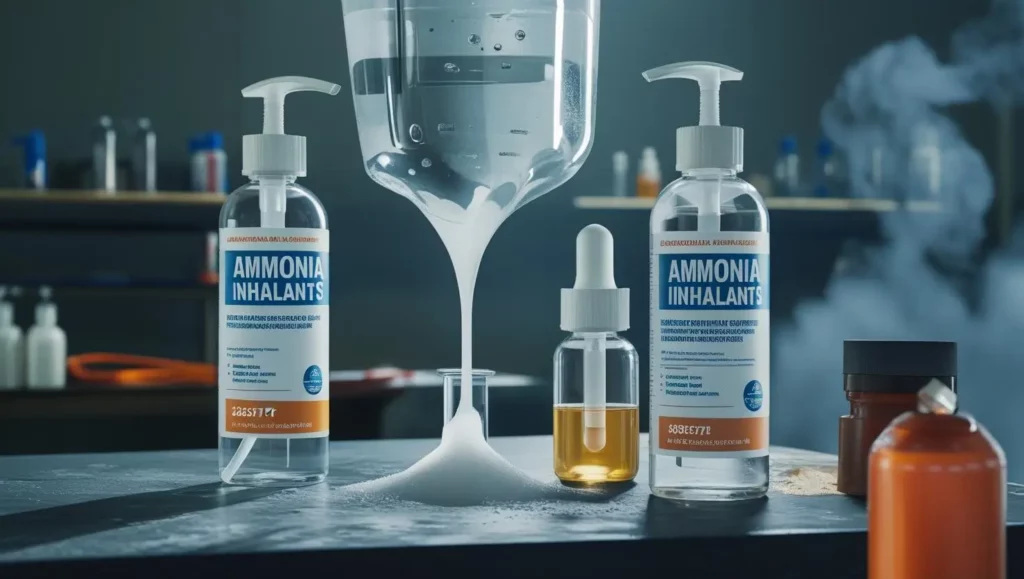Ammonia Inhalants: Uses And Risks
What are Smelling Salts?
Ammonia inhalants, commonly known as “Smelling salts,” are inherently colorless gasses that exude a pungent smell at room temperature. Smelling salts, a blend of ammonium carbonate ((NH4)2CO3H2O), include Ammonia gas that becomes aqueous Ammonia upon dissolving into water. When contacting air, its state changes from liquid to gas.

Due to the nature of their distinctive smell, smelling salts are specifically prepared to be used as stimulants to restore and rouse the consciousness and focus of individuals. Initially formulated by the Romans, ammonia inhalants have been used as a medical treatment to cure dizziness and fatigue. However, smelling salts weren’t commonly used until the Victorian era. Smelling salts also gained popularity in the 1920s as they were used to cure fainting pregnant women.
In this blog, we explore all aspects of Ammonia, from its chemical composition to its common uses, side effects, and health hazards, as well as OSHA guidelines and regulations involving ammonia refrigeration.
What are Smelling Salts Used For?
During the 17th century, experimenters performed a distillation procedure using aqueous ammonia solution and shavings from the horns and hooves of harts. The resulting crystallized substance was identified as ammonium carbonate; hence, it became known as the spirit of hartshorn. Over the years, it acquired the name “Smelling Salts” when blended with scents.”

Smelling salts are mostly a mixture of ammonium carbonate and perfume or a blend of diluted Ammonia, water, and ethanol. When inhaled, the smelling salts cause a sensation of awakening by triggering the membranes of the nose and lungs. The resulting “inhalation reflex” accelerates the breathing and heart rate, further stimulating the “fight or flight” response and causing an adrenaline rush. In layman’s terms, it boosts the body, causing wakefulness, concentration, and increased energy, though the effects are short-lived, lasting only for a few minutes.
Historically used in medicine to prevent and treat dizziness and fainting, smelling salts have become popular among present-day athletes to improve focus and perform better during intense physical activities and sports such as boxing, football, hockey, powerlifting, etc. In 2005, Michael Strahan, a well-known media personality, determined that 70–80% of National Football League players used smelling salts as stimulants.
In addition, smelling salts are often used by athletic trainers on athletes who have been dazed or have lost consciousness due to a head injury to reinstate mental alertness and consciousness.
Potential Side Effects of Smelling Salts
Smelling salts are typically safe to help someone restore consciousness after lightheadedness. However, as of yet, no clear evidence has come to the surface to prove the safety of the constant use of smelling salts.

It is estimated that a higher amount of ammonia concentration in the workplace or nearby environment and the duration of exposure can accelerate a person’s risk of dangerous health outcomes. Though exposure to 250 ppm of Ammonia for under 1 hour can be tolerated by many, exposure to more than 50 ppm of Ammonia for more than 2 hours can begin irritation to the eyes, nose, and throat. Moreover, exposure to Ammonia concentrations between 2,500-4,500 ppm for more than 30 minutes can be fatal.
Besides, anhydrous Ammonia, commonly used as a refrigerant in most industries, can seriously threaten workers from direct contact with skin due to spills, inhalation, explosion, and fire. Potential side effects involving exposure to Ammonia include coughing, headache, vomiting, shortness of breath, and even diarrhea.
Furthermore, individuals with preexisting respiratory system conditions may experience more adverse reactions, including Asthma, Bronchitis, Emphysema, and even Chronic lung disease.
OSHA Standards for Ammonia Inhalants
In order to ensure the well-being of workers and promote safe working conditions, the Occupational Safety and Health Administration (OSHA) has enacted specific regulations regarding the uses and storage of Ammonia. Therefore, workers must enroll in the OSHA 30-Hour General Industry online training course to obtain in-depth knowledge of ammonia refrigeration discussed in OSHA standards for the general industry 29 CFR 1910.

Upon completing Ammonia awareness training, participants will learn the common health hazards involving Ammonia and the safety measures to counter potential risks.
Workers can prevent contact with skin, eyes, nose, and mouth by wearing personal protective equipment (PPE). Since Ammonia is a corrosive chemical that can irritate and burn whatever comes in contact with it, individuals must stay conscious when using it, whether in the form of smelling salts or compressed gas. For individuals using smelling salts for the first time, whether capsuled or bottled, it’s advised not to hold them any closer than 15 cm to prevent potential danger.




